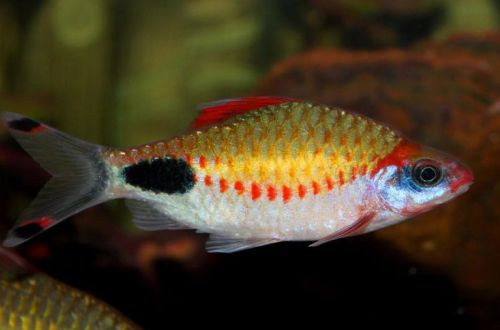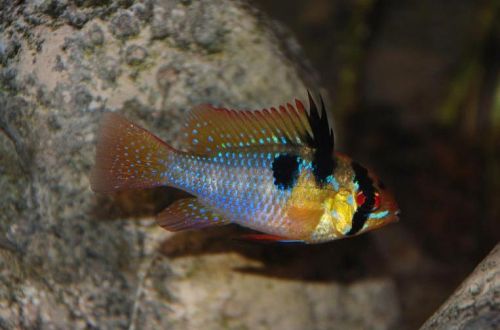
Barbus Dawkins
Dawkins Barb or Shaded Barb, scientific name Dawkinsia assimilis, belongs to the family Cyprinidae (Cyprinidae). The fish is named after the English evolutionary biologist Richard Dawkins. It is considered easy to keep and breed, goes well with other aquarium fish. May be recommended for beginner aquarists.

Contents
Habitat
It comes from the western part of the Hindustan peninsula from the territory of modern India (states of Karnataka and Kerala). Found in various biotopes. Inhabits mountain rivers with fast clean water, as well as flat water bodies in river basins with slow flow and muddy waters.
Brief information:
- The volume of the aquarium – from 240 liters.
- Temperature – 19-25°C
- Value pH — 6.0–7.0
- Water hardness – 2–10 dGH
- Substrate type — stony
- Lighting – low, moderate
- Brackish water – no
- Water movement – light or moderate
- The size of the fish is 9–12 cm.
- Feeding – any food of suitable size
- Temperament – peaceful
- Keeping in a group of 8-10 individuals
Description
Adult individuals reach a length of up to 12 cm. Outwardly, it resembles its close relative Barbus filamentosus, which is why they are often confused. Males are more colorful than females, but are smaller. A characteristic feature of the body pattern is a red dotted line along the lateral line and a large black spot at the base of the tail. The dotted line visually divides the body into two parts – golden on top and silver on the bottom. Black and red speckles are visible at the tips of the tail. In males during the spawning period, small growths are formed on the head – tubercles.
Food
A low-maintenance species that will accept most popular foods designed for aquarium fish of a suitable size. The quality and composition of the products directly affect the color, so it is recommended to purchase food from trusted manufacturers.
Maintenance and care, arrangement of the aquarium
The optimal tank sizes for a small flock of these fish start at 240 liters. The design is arbitrary, at the discretion of the aquarist. However, an aquarium resembling a section of a mountain stream is considered the best choice for Barbus Dawkins. Such a design will require rocky ground with several large boulders and snags, as well as a limited number of unpretentious plants, such as anubias, and aquatic mosses, ferns. You can use artificial plants.
Since the fish originate from flowing waters, they are sensitive to the accumulation of organic waste in the water, so maintaining stable water conditions is the key to successful management. Mandatory aquarium maintenance procedures are standard and include: weekly replacement of part of the water (30–50% of the volume) with fresh water, cleaning the soil and design elements, equipment maintenance, monitoring pH / dGH / oxidizability parameters.
Behavior and Compatibility
A peaceful agile fish, compatible with many other freshwater non-aggressive species of comparable size. It is recommended to acquire a flock of at least 8–10 individuals of different sexes and further maintain the size of the group at this level.
Breeding / breeding
In favorable conditions, spawning occurs regularly. Females scatter eggs in the water column, and males fertilize them. The incubation period lasts 24-48 hours, after another day the fry begin to swim freely in search of food. Parental instincts are not developed, so there is no concern for offspring, moreover, adult fish will, on occasion, eat their own offspring. Thus, the survival rate of fry in the general aquarium will be minimal.
A more controlled approach to breeding Barbus Dawkins is associated with a spawning aquarium, where the eggs are placed immediately after spawning. This is a small tank with a volume of 10 liters or more with identical water conditions, equipped with a simple airlift filter with a sponge and a heater. A separate light source is not required, the light entering their premises is quite enough.
Fish diseases
In a balanced aquarium ecosystem with species-specific conditions, diseases rarely occur. Diseases are caused by environmental degradation, contact with sick fish, and injuries. If this could not be avoided, then more about the symptoms and methods of treatment in the section “Diseases of aquarium fish”.





